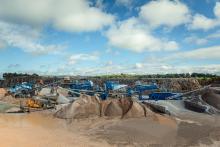
A big increase in quality aggregates production and lower operational costs have enabled the Indian crushing plant major LSC Infratech to boost profitability at one of its state-of-the-art plants. Partha Pratim Basistha reports
LSC Infratech's (LSC) major crushing and screening facility at Gharti village in Bharatpur (LSC Ghatri), in the north Indian state of Rajasthan, is a best-practice example to the wider Indian aggregates sector. The site's advanced operating practices include a compact crushing and screening plant configuration and the optimised layout of the conveying systems connected to the crushing and screening, manufactured and silica sand production units. It is a setup that has seen the facility's operating costs plummet.

Commenting on LSC's Ghatri operation, LSC director Saurabh Agarwal says: "We have put in multiple [production] trains at Bharatpur, ranging from producing aggregates to manufactured and silica sand. This allows us to derive wider processed-materials throughput to make operations profitable in the highly competitive Indian aggregates business.
"Ever since the commissioning of the [Ghatri] plant in 2013, we have been bringing in advanced technologies and operating and maintenance processes over the years. This has been possible through our long-drawn expertise in running crushing and screening plants across north India."
LSC's Ghatri facility is a major supplier of aggregates to road and railway infrastructure projects in north India. The facility also supplies silica sand to foundries and glass industries in parts of Uttar Pradesh, Rajasthan, Haryana and Uttarakhand in north India.
LSC Ghatri's silica sand gives shape to iron and separates the molten iron from dye. Atul Engineering, a prime railway equipment manufacturer, and Prakash Agro Equipment Industries in Uttar Pradesh are among LSC Ghatri's key silica sand customers.
"Another of our prime [silica sand] customers is Japanese glass-producing major Asahi India Glass, who have a monthly requirement of 11,000 tons of sand," says Agarwal. "We also supply close to sixty tons of dry silica sand to ladies' glass-bangle-producing units in Uttar Pradesh."
Aggregates production at the facility is carried out by 300-tonnes per hour Terex India plants. This comprises a grizzly jaw (JW 1175), a cone crusher (TC 1300), and a four-deck screen. The plant line produces 0-8mm granular subbase materials through the grizzly jaw, fed to the washing plant. The plants also produce 10–20mm aggregates products and 0-4mm dust. A Propel Industries' QM 250 cone crusher paired with a three-deck screen produces 0-4mm dust products.
"The Terex India and Propel Industries' programmed-logic-enabled plants run 16 to 20 hours daily. To ensure their smooth and continued operation, we have created a stockpile through engineering modifications to the conveyors. The stockpile can hold between 1200-1500 tons of material. During shutdown maintenance for any of the three plants, the stockpiles can give backup product support, backed by the custom-engineered conveying systems," explains Omkar Singh, plant manager for the facility. The plants produce close to 40,000 tons of aggregates per month. However, this can be scaled up to even 60,000 tons per month, based on the market demand."
Singh continues: "Based on the space available for setting the plant, we have tried to make the layout of the conveying systems compact. This allows us to better control conveyor running hours, saving electricity costs. It also enables us to reduce necessary maintenance and the replacement of drives, motors, idlers and rollers."
To minimise operation costs, and similar to LSC's Karoli plant, the Ghatri facility has swivel conveyors connected to the manufactured and silica sand plant. It transports and stocks the manufactured and silica sand variants at the stockyard. "The swivel or radial conveyors facilitate easy segregation of the manufactured and silica sand. However, most significantly, it allows us to have less transportation costs through curtailing usage of rigid dump trucks or wheeled loaders for transporting the sand from the plant to the stockyard," says Singh.
"Our wholesome approach has been to make the operations of the Ghatri plant commercially viable and sustainable in the long term through producing quality throughput across the lifecycle of the plants," says Agarwal.
LSC Ghatri's silica sand beneficiation plant produces 300 tonnes daily. This can be increased to 400 tonnes per day, based on demand. The plant produces 100-500 microns of sand for the glass industries. For iron foundries, it produces between 100-850 microns of sand. The plant was purchased from Weir Minerals, Bangalore, a full Weir Minerals (UK) subsidiary. The plant contains a Metofabrik-manufactured classifier from which the material is passed to a three-deck vibration screen. It is then conveyed to a dewatering screen and fed to a Linatex (USA) T-type classifier supplied by Weir Minerals. The desired size of the sand cut point is achieved by optimising water pressure. After washing, the silica sand is stockpiled via a customised radial stacker conveyor and stored under cover while awaiting dispatch.
"We decided to select Weir Minerals as our preferred equipment supplier as we were convinced of their higher reliability and productivity attributes and superior service levels compared to other solutions providers. We were more convinced after Weir Minerals showed us how similar sand beneficiation was done with their plants in Australia," explains Agarwal.
He adds: "We are an environmentally cautious organisation. As such, 100% of the water used in our production process is recycled using a state-of-the-art high-rate thickener (HRT) supplied by McNally Sayaji Bangalore. Recently, we have also added a filter press. This further extracts the slurry from the HRT, thus recovering water to produce soil cakes. We sell the caked materials to brick producers."
Agarwal says LSC Ghatri's industrial silica sand is produced through triple-washing. "This makes it clean, uniformly sized, high-quality silica sand that is bonded to form moulds for ferrous (iron and steel) and non-ferrous ( copper, aluminous, brass) metal castings."
Deploying cutting-edge loading and hauling machines further lowers the company's operating costs. The site runs a fleet of Tata (India) 6x4 rigid dump trucks (RDTs) with bodies from Hyva India. The trucks include Tata Bharat Stage II (2014), Stage IV (2019) and new Stage VI (2022) engines.
Singh says: "Tata RDTs have been procured due to the very good onsite product support we get from the Rajasthan-based Tata dealership. The trucks also deliver higher productivity by hauling more cargo volumes with faster cycle times and higher levels of fuel efficiency with the BS VI engines. This makes the unit costs of transportation cheaper for us."
The Tata trucks operate internally, transporting the raw materials from the quarry to the crushing plant. "Due to the heavy boulder weights, we have modified the truck bodies by thickening the inner plates from 4mm to 6mm. Plate thickening has been done to haul more loads as well," says Singh.
Singh says LSC Ghatri is also pleased with its eight fuel-efficient Volvo EC210D excavators and Komatsu 210 LC excavator. The machines are used for loading the manufactured silica sand on the conventional, wooden-bodied Tata haulage trucks for dispatch from the stockyard and for loading crushed aggregates.









